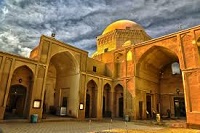Gonbad-e Ali (Gonbad-e Ali Abarkuh): A Monument of Historical Significance
Located in Abarkuh, approximately 140 kilometers west of Yazd, Gonbad-e Ali, also known as Gonbad-e Ali Abarkuh, is one of the most prominent historical landmarks in the province of Yazd, Iran. The town of Abarkuh is famous not only for the Abar Kooch cypress tree, one of the oldest trees in the world but also for this remarkable architectural structure that dates back to the Seljuk period.
Historical Significance
Gonbad-e Ali is an outstanding example of Seljuk architecture. It was built during the 12th century (approximately in the Seljuk dynasty), a period known for the flourishing of Persian art, culture, and architecture. The tomb’s construction reflects the Islamic architectural trends of the time, characterized by its elegant domed structure, intricate brickwork, and decorative elements that showcase the artistic achievements of the era.
The Gonbad-e Ali serves as a mausoleum, and while its precise historical context is still debated, it is generally believed to be the tomb of a notable figure or local dignitary. Its grandeur and strategic placement in Abarkuh suggest its importance both as a tomb and a symbol of the region’s wealth and cultural significance during the Seljuk period.
Architectural Features
One of the most striking features of the Gonbad-e Ali is its dome, which is beautifully designed and one of the largest in the region. The dome is conical in shape and stands tall against the skyline, making the monument visible from a distance. This architectural feature is a characteristic of Seljuk tombs, where large domes were often used to symbolize the heavenly realm and the divine.
The structure is constructed with brick, which was a common building material during the Seljuk period. The bricks are laid with great precision, creating a highly aesthetic and durable structure. The entrance to the mausoleum is also grand, and the design includes detailed geometric patterns that are typical of Islamic architecture. The use of archways and vaulted ceilings inside adds to the grandeur and majesty of the building.
The outer façade is adorned with intricate tilework and features a calligraphic inscription that provides insight into the era and the cultural influences of the time. The walls of the tomb also display a blend of abstract motifs and floral designs, reflecting the aesthetic preferences of the Seljuk dynasty.
Cultural Significance
In addition to its architectural and historical importance, Gonbad-e Ali holds cultural significance in the region. It is an enduring symbol of the artistic and intellectual achievements of the Seljuk era, a time when Iran was a cultural hub of the Islamic world. The tomb’s location in Abarkuh, a city that has witnessed the rise and fall of several Persian empires, makes it an important part of the region’s history.
The Gonbad-e Ali has also become a popular tourist destination. Its architectural beauty and serene atmosphere attract visitors, both locals and foreigners, interested in exploring the rich history of Yazd province and the Seljuk period. The site is often visited by historians, architects, and travelers eager to witness the grandeur of Persian Islamic architecture.
Modern-Day Relevance
Today, Gonbad-e Ali stands as a symbol of the Seljuk dynasty’s architectural prowess and Iran’s rich historical heritage. It continues to be a place of interest for both scholars and tourists. The tomb serves as a reminder of Iran’s architectural ingenuity and its influence on later Islamic architectural styles across the region.
Additionally, the Gonbad-e Ali is often used for educational purposes, where its design and construction techniques are studied by architects and historians alike. The preservation of this monument ensures that future generations will have the opportunity to learn about the rich cultural history of Abarkuh and Seljuk architecture.
The Gonbad-e Ali (Gonbad-e Ali Abarkuh) is a magnificent historical and architectural landmark that represents the beauty and grandeur of Seljuk architecture. It is a lasting symbol of the Seljuk dynasty’s cultural and architectural contributions to the Islamic world. Whether for its historical importance, architectural elegance, or cultural significance, Gonbad-e Ali remains one of the most treasured monuments in Abarkuh and the wider Yazd province of Iran.




